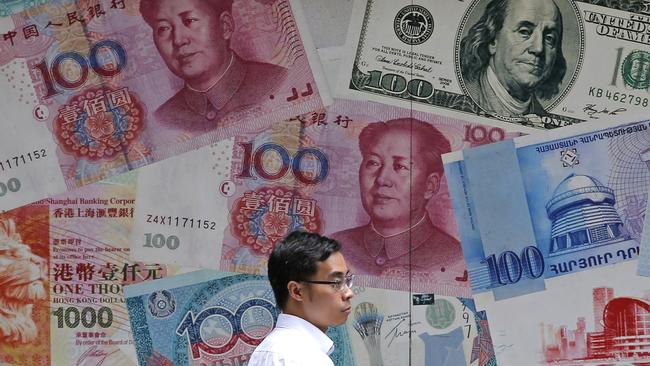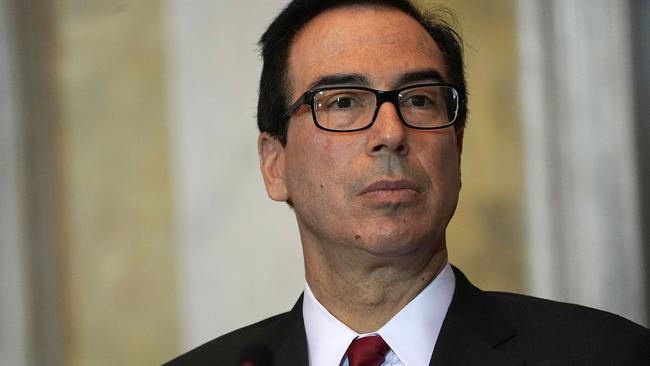China keeps rein on yuan after US labels it a currency manipulator
China has kept the yuan on a tight leash after the US labelled it a currency manipulator.

The Chinese yuan — the focus of the latest escalation in friction between the US and China — has stabilised in early Asian trade, a sign that Beijing might not permit a steep depreciation.
China’s central bank helped temper market nerves by lowering the value of the yuan by less than expected against the greenback at its daily parity fix this morning.
Although the People’s Bank of China set the yuan 0.66 per cent weaker at 6.9683 yuan against the US dollar, it kept the currency below the symbolic 7 yuan per dollar level that it breached during trading yesterday and also undershot Bloomberg’s consensus estimate of a 6.9871 yuan fix.
The more freely traded offshore yuan strengthened 0.2 per cent in Hong Kong to 7.0828 after falling as low as 7.1397 per dollar in early Asian trade. The onshore yuan was little changed against the greenback at 7.0476.
US futures reacted to the more moderate move by paring falls of 1.9 per cent in early Asian trade to be down 0.6 per cent at around 11.30am (AEST).
The Australian dollar was buoyed by the Chinese central’s bank move bouncing off an almost decade low of US67.50c. The S&P/ASX 200 share index hit a post-open intraday high of 6492, but is still down 2.2pc.
Major markets in the region also remain mired in the red, with Hong Kong and Japan’s bourses down more than 2 per cent. China’s Shanghai Composite fell 1.9 per cent, while South Korea’s Kospi declined 1.6 per cent, all building on retreats the previous day.
Chinese monetary authorities let the yuan slide past the 7 level yesterday so that markets could finally factor in concerns around the Sino-US trade war and weakening economic growth, three people with knowledge of the discussions told Reuters on Monday.
The more moderate-than-expected rate fixing by China came after the US Treasury labelled China as a currency manipulator after its central bank let the yuan depreciate yesterday, sharply escalating the trade conflict and stoking fears that the widening clash could disrupt America’s economy.
The Treasury Department said China allowed the yuan to slip in value in as a means of gaining an unfair competitive advantage, and that Treasury Secretary Steven Mnuchin would seek corrective action from the International Monetary Fund.
The development came after a day of back and forth over trade between the world’s two largest economies that sent global financial markets reeling, with the Dow Jones Industrial Average falling 767 points, or 2.9 per cent, to 25,717.74 and the S&P 500 index falling 3 per cent to 2,844.74.
With no end to the conflict in sight, the uncertainty could also pressure the Federal Reserve to consider more interest- rate cuts, following its decision last week to reduce its benchmark overnight-lending rate by a quarter percentage point.

The People’s Bank of China is also set to issue 30 billion yuan ($US4.25 billion) in central bank bills in Hong Kong, it said today, in what could be viewed as a move to limit possible yuan short-selling.
Sales of central bank bills withdraw yuan liquidity from offshore markets and the latest such transaction comes a day after the Chinese currency fell beyond the psychologically-important mark of 7 yuan per US dollar as China’s trade conflict with the US intensified.
The yuan’s depreciation will make Chinese goods more attractive in foreign trade, but economists say Beijing doesn’t want there to be the sort of sharp devaluation that would stoke capital flight risks seen in 2015.
US officials had been expecting retaliation from Beijing after President Trump vowed last week to impose 10 per cent tariffs starting 1 September on about $US300 billion in Chinese goods that are now not subject to levies. But Mr Trump indicated then that he could ratchet levies even higher — even above 25 per cent — as he complained that China hasn’t followed through on expectations it would buy more American farm products.
China’s central bank said the depreciation was “due to the effects of unilateralist and trade-protectionist measures and the expectations for tariffs against China”. And on Tuesday, the state-owned Xinhua News Agency reported that relevant Chinese companies had already suspended purchases of US agricultural products, and that the government “will not rule out import tariffs on newly purchased US agricultural products after 3 August.
Mr Trump has long complained that China keeps the value of yuan currency artificially low to make its goods cheaper on global markets. Analysts, however, say China is unlikely to let the currency decline more sharply, which could trigger an exodus of capital.
“The announcements from Beijing represent a direct shot at the White House and seem designed for maximum political impact,” said Chris Krueger, strategist at Cowen Washington Research Group. “We expect a quick — and possibly intemperate — response from the White House, and consequently expect a more rapid escalation of trade tensions.” The White House had no immediate comment on next steps in the trade conflict Monday, but some close observers expect the US to take a pause before taking any countermeasures.
“This is not a surprise,” said Derek Scissors, a senior trade expert at the American Enterprise Institute, who occasionally consults with the administration. “There’s nobody with an agenda that wants to respond to this, with the possible exception of the boss.” In the US, the move has already added pressure on the Fed to continue lowering interest rates. Futures markets are currently pricing in an 89 per cent chance of at least two more rate cuts in 2019, up from 39 per cent last Wednesday, according to CME Group.
The administration could also tap an instrument known as the Exchange Stabilisation Fund to intervene in currency markets in response, Mr Krueger said. Another option is for the administration to accuse China formally of currency manipulation through the Treasury Department.
China is intent on continuing to receive the hundreds of Billions of Dollars they have been taking from the U.S. with unfair trade practices and currency manipulation. So one-sided, it should have been stopped many years ago!
— Donald J. Trump (@realDonaldTrump) August 5, 2019
“It’s called ‘currency manipulation,’” Mr. Trump said Monday morning in a tweet. “Are you listening Federal Reserve? This is a major violation which will greatly weaken China over time!”
Fed Chairman Jerome Powell said last week that trade uncertainty was curbing business investment, which is one reason the central bank lowered in benchmark rate by a quarter percentage point to a range between 2 per cent and 2.25 per cent. It was the Fed’s first rate cut in over a decade.
Mr Powell last week held open the door for another rate cut later this year but suggested the Fed didn’t see a need for the kind of more aggressive action reserved for periods where the economy looks headed for a recession.
Mr Powell “will ultimately have to eat his words” that last week’s rate cut was a “midterm correction in rates,” said Scott Anderson, chief economist at Bank of the West. “The July rate cut is, in fact, only the first in a series of cuts that will be needed to forestall an outright economic recession in the United States.” Immediately after last week’s meeting, investors in futures markets had placed just a 50 per cent probability of one quarter-point rate cut at the central bank’s next meeting on September 17-18. By Monday morning, investors had placed a 100 per cent probability of at least one rate cut by September, with a nearly 25 per cent chance of a half-point cut.
“When the Fed does cut rates again, it may appear on the surface that it is bowing to White House pressure. What it will actually be doing is responding to the real-world fallout from the White House’s disruptive rhetoric,” said Lou Crandall, chief economist at financial-research firm Wrightson ICAP, in a report on Sunday.
Mr Trump has vocally criticised the Fed for not cutting rates and on Monday pointed to the growing fallout from the trade escalation as a reason for the Fed to act. Mr. Crandall said the White House’s rhetoric was only likely to alter the Fed’s policy if it succeeded in weakening economic growth prospects, “which makes it a fundamentally self-defeating strategy.”
Two Fed officials dissented against last week’s decision, the most in Mr. Powell’s 18-month tenure as chairman, because they didn’t think the economy warranted lower rates.
Mr. Powell last week said the trade uncertainty was harder for the Fed to forecast than other potential policy shocks, both because there is less recent experience of tariff escalation between major trading partners and because of the mercurial nature of the administration’s negotiations.
“After simmering early in the year, trade policy tensions nearly boiled over in May and June, but now appear to have returned to a simmer,” Mr. Powell said.
The escalation of trade tensions in May and June had prompted discussions of a rate cut in June, but a cease fire between Mr. Trump and Chinese President Xi Jinping at the end of June following a meeting at the G-20 summit in Japan had lessened the prospects of escalation.
The PBOC has insisted the value of its currency is determined by the market, though traders say it had been supporting the currency when it threatened to breach the key level over the past year. The China Daily said in an editorial on Tuesday that the yuan was weak as a result of “unilateral and protectionist moves by the US government” and said long-term exchange rates were decided by “economic fundamentals”. China’s commerce ministry announced overnight that its companies had stopped buying US agricultural products in retaliation against a move announced by Washington to raise levies on Chinese goods from September 1.
The Wall Street Journal, Reuters



To join the conversation, please log in. Don't have an account? Register
Join the conversation, you are commenting as Logout